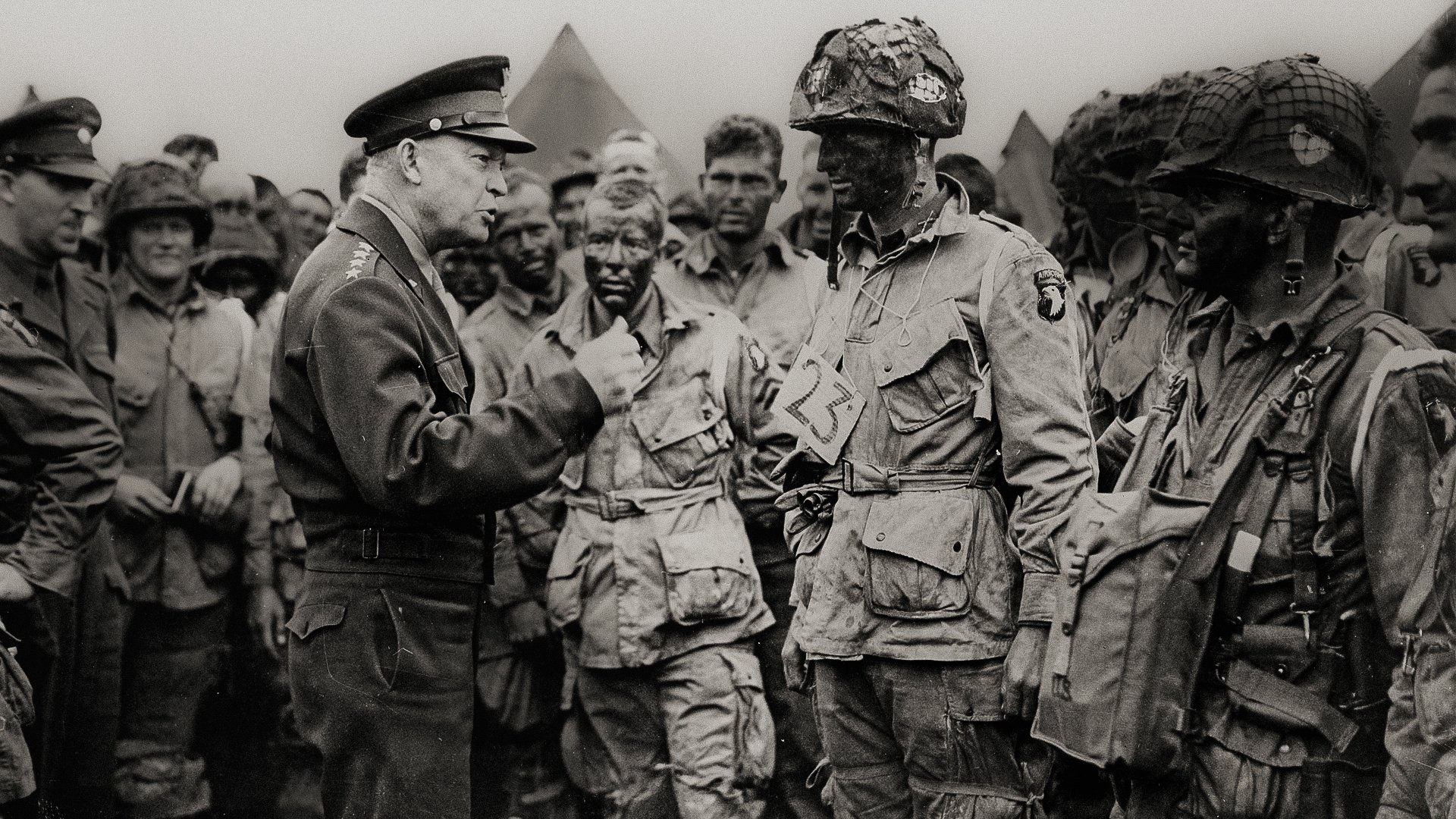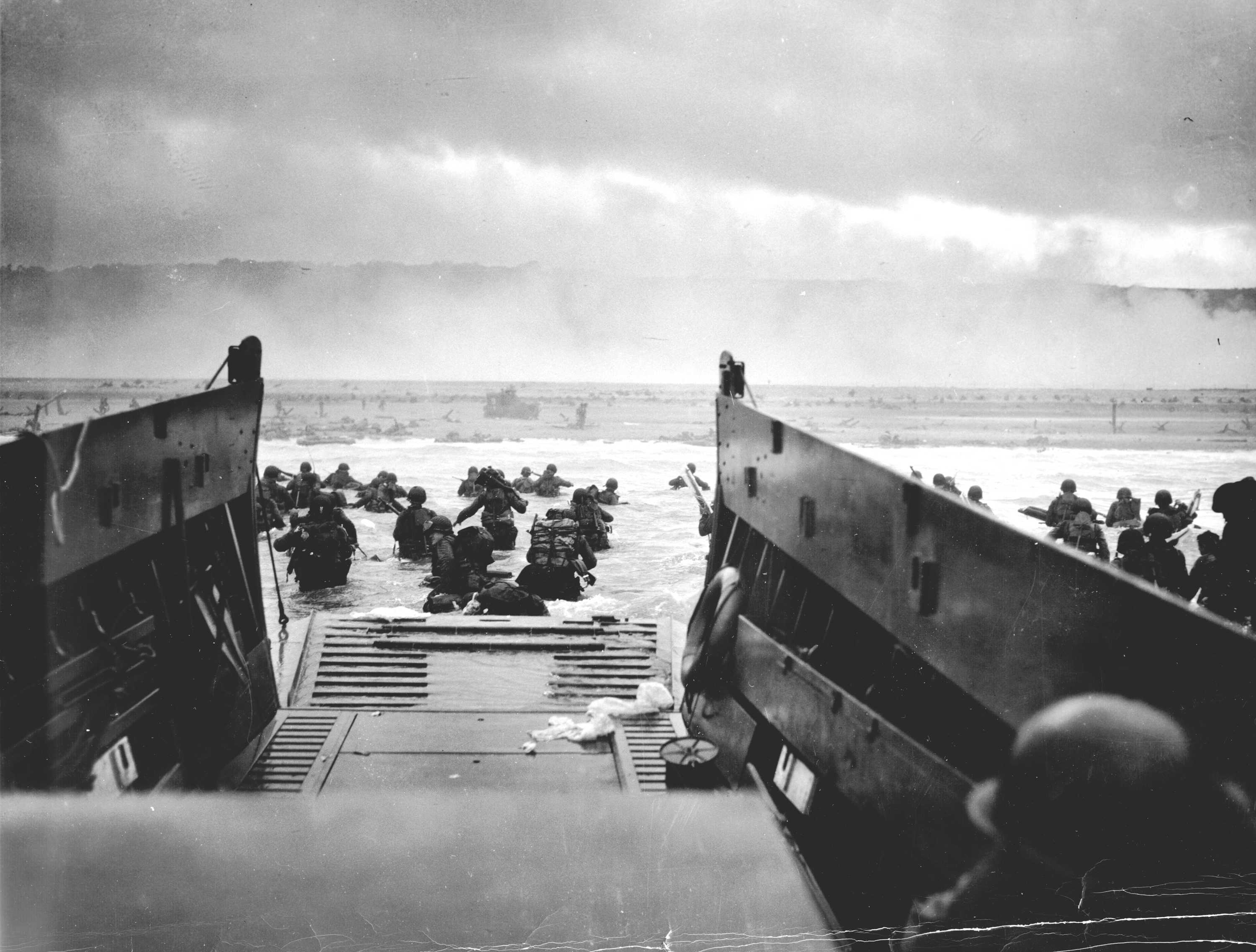
June 6, 1944. 156,000 Allied troops hit five beaches along fifty miles of French coastline. The largest amphibious invasion in history. The beginning of the end for Nazi Germany.
The Plan

By 1944, Hitler controlled most of Europe. Britain stood alone in the west. Stalin pushed from the east but needed help. America had been in the war since the attack on Pearl Harbor. The Allies needed a second front.
General Dwight D. Eisenhower commanded the operation. Code name: Operation Overlord. The target: Normandy, France. The mission: establish a foothold, break through German defenses, liberate France, drive to Berlin.

Weather delayed the invasion by one day. Eisenhower gave the order on June 5th. There would be no turning back.
The Forces
Five beaches. Five assault forces.
Utah Beach: U.S. 4th Infantry Division
Omaha Beach: U.S. 1st and 29th Infantry Divisions
Gold Beach: British 50th Infantry Division
Juno Beach: Canadian 3rd Infantry Division
Sword Beach: British 3rd Infantry Division
Behind them came the 82nd and 101st Airborne Divisions. They dropped inland before dawn to secure key positions and cut German supply lines.
Thirteen nations contributed forces. The United States, Britain, and Canada led the assault. Free French forces fought alongside them. Poles, Norwegians, Czechs, Greeks, Dutch, Belgians, and others filled the ranks.
The Fight
Show Image Paratroopers of the 82nd and 101st Airborne Divisions drop into Normandy in the early hours of June 6, 1944.
At 0100 hours, 13,000 American paratroopers jumped into darkness over Normandy. High winds scattered them across the countryside. Many landed miles from their objectives. Equipment got lost. Units fragmented.
Lieutenant Richard Winters of Easy Company, 506th Parachute Infantry Regiment, landed alone in a field. He spent the night gathering scattered men. At dawn, they assaulted a German battery at Brecourt Manor. Four guns. Fifty German soldiers. Winters had twelve men.
They took the position. Destroyed the guns. Minimal casualties. It's still taught at West Point.
Private John Steele of the 505th Parachute Infantry Regiment caught his chute on the church steeple in Sainte-Mère-Église. He hung there for two hours, playing dead while the battle raged below. Germans eventually cut him down and took him prisoner. He escaped three days later.
Utah Beach
Show Image Men and equipment of the 4th Infantry Division move inland from Utah Beach, June 6, 1944.
Utah Beach went well. Strong currents pushed landing craft 2,000 yards south of the planned zone. Brigadier General Theodore Roosevelt Jr., son of the president, went ashore in the first wave. At 56, he was the oldest man and the only general in the initial assault.
Roosevelt surveyed the situation. Wrong beach, lighter resistance. He made the call: "We'll start the war from right here."
The 4th Infantry Division moved inland. By day's end, 23,000 men came ashore. Casualties: 197.
Omaha Beach

Omaha Beach was hell.
The planners got it wrong. Intelligence missed a full German infantry division stationed on the bluffs. Naval bombardment fell short. Bombers missed their targets. The first waves hit an intact, alert enemy in reinforced positions.
Landing craft dropped ramps. Machine guns opened up. Men fell before they reached the water. Those who made it to the beach found themselves pinned down under a seawall with no cover.
Company A, 116th Infantry Regiment landed at 0630. Within minutes, 96% were casualties. Dead, wounded, or pinned down and unable to move.
Ranger Sergeant Raymond Keller dragged wounded men to cover all morning. A sniper shot him in the shoulder. He kept moving men. He took a second round to the leg. He continued until blood loss forced him down. He lived.
Around 0800, small groups started moving. Bangalore torpedoes blew gaps in wire obstacles. Men crossed the beach in ones and twos. They climbed the bluffs. They flanked German positions. They fought bunker to bunker.
No single hero turned Omaha Beach. Hundreds of small decisions by terrified men who moved anyway. By afternoon, they controlled the bluffs. By evening, 34,000 men were ashore.
Show Image American soldiers use German beach obstacles for cover during the assault on Omaha Beach, June 6, 1944.
Casualties: 2,400.
Gold, Juno, and Sword

British and Canadian forces faced their own fights on the eastern beaches. German resistance varied by sector. Some units walked ashore unopposed. Others took heavy fire.
The Canadian 3rd Division at Juno Beach faced rough seas and underwater obstacles. Landing craft hung up on beach defenses. Engineers worked under fire to clear paths. The Canadians pushed inland seven miles by nightfall. Deeper than any other Allied force that day.
British forces on Gold and Sword connected their beachheads and linked with the Canadians. They failed to reach their ambitious first-day objective of Caen. That fight would last six weeks.
The Rangers at Pointe du Hoc
Show Image U.S. Army Rangers scale the 100-foot cliffs at Pointe du Hoc using rope ladders under German fire, June 6, 1944.
Between Utah and Omaha stood Pointe du Hoc. A 100-foot cliff topped with German gun batteries that could rake both beaches. The 2nd Ranger Battalion drew the mission.
225 Rangers landed at 0710 under heavy fire. They fired rocket-propelled grappling hooks up the cliff face. Ropes. Ladders. They climbed while Germans shot down at them and cut ropes.
Colonel James Rudder led them up. They took the position in fifteen minutes of close combat. The guns weren't there. Intelligence was wrong again. The Rangers pushed inland and found the guns hidden in an orchard. They destroyed them with thermite grenades.
The Rangers held Pointe du Hoc for two days against counterattacks. Relief finally arrived on June 8th. Of 225 Rangers who landed, 90 could still fight.
Show Image The cratered battlefield at Pointe du Hoc, showing the devastation from naval and aerial bombardment. The Rangers fought across this terrain.
The Cost
Show Image The Normandy American Cemetery at Colleville-sur-Mer overlooks Omaha Beach. 9,388 American service members are buried here.
By midnight on June 6th, the Allies controlled the beaches. The foothold was thin but real. Over 4,400 Allied troops died that day. More than 5,000 wounded. Thousands more missing or captured.
The 1st Infantry Division at Omaha Beach and the 29th Infantry Division beside them took the highest casualties among American units. The British 3rd Division at Sword Beach suffered heavily from German counterattacks.
German casualties remain uncertain. Estimates range from 4,000 to 9,000 killed and wounded.
What It Meant
D-Day wasn't the end. It was the door.
The Allies broke out of Normandy in August. Paris fell on August 25th. The Rhine crossings came in March 1945. The war in Europe ended May 8th, 1945.
None of it happens without Normandy. Without men who crossed that beach when every instinct screamed to stay down. Without leaders who made hard calls with incomplete information. Without nations that put aside differences to face a common evil.
Those Who Remain
Fewer than 1% of D-Day veterans survive today. They're in their late 90s and beyond. When they're gone, D-Day passes from memory into history.
We remember them while we can. We learn their stories. We understand what they did and why it mattered. We pass it to the next generation.
Every June 6th, we stop. We think about those beaches. About men who were 18, 19, 20 years old doing impossible things because someone had to do them.
That's what we commemorate. That's what we honor. That's what we never forget.
For Those Who Serve Today
D-Day sets the standard. Combined arms. Allied cooperation. Mission focus over personal safety. Leaders who lead from the front.
The tools change. The technology advances. The core mission remains: face down evil when it rises. Stand with allies. Complete the mission. Bring your people home.
The men of D-Day did that. They paid for it with blood and bodies on a French beach. They won anyway.
That's the legacy. That's the example. That's what June 6th means to those who wear the uniform today.
We remember. We honor. We carry it forward.
Semper Fidelis.







